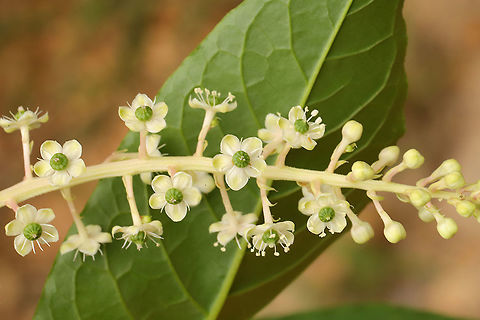
Appearance
Pokeweed is a member of the family Phytolaccaceae, and is a large herbaceous perennial plant, growing up to 2.5 metres in height over the course of a summer. One to several branches grow from the crown of a thick, white, fleshy taproot; Michael D. K. Owen describes the branches as "stout, smooth, [and] green to somewhat purplish". Simple, entire leaves with long petioles are alternately arranged along the stem.Pokeweeds reproduce only by their large, glossy black, lens-shaped seeds, which are contained in a fleshy, 10-celled, purple-to-near-black berry that has crimson juice. The flowers are perfect, radially symmetric, white or green, with 4–5 sepals and no petals. The flowers develop in elongated clusters termed racemes. The seeds have long viability, able to germinate after many years in the soil.This section needs additional citations for. Please help improve this article by adding citations to reliable sources in this section. Unsourced material may be challenged and removed.
"Plant Type": Perennial herbaceous plant which can reach a height of 3 m but is usually 1.2 to 2 m. The plant must be a few years old before the root grows large enough to support this size. The stem is usually red late in the season. There is an upright, erect central stem early in the season, which changes to a spreading, horizontal form later with the weight of the berries. The plant dies back to the roots each winter. The stem has a chambered pith.
"Leaves": The leaves are alternate with coarse texture with moderate porosity. Leaves can reach 41 centimetres in length. Each leaf is entire. Leaves are medium green and smooth, with a distinct odor that many characterize as unpleasant.
"Flowers": The flowers have 5 regular parts with upright stamens and are up to 5 millimetres wide. They have white petal-like sepals without true petals, on white pedicels and peduncles in an upright or drooping raceme, which darken as the plant fruits. Blooms first appear in early summer and continue into early fall.
"Fruit": A shiny dark purple berry held in racemose clusters on pink pedicels with a pink peduncle. Pedicels without berries have a distinctive rounded five part calyx. Fruits are round with a flat indented top and bottom. Immature berries are green, turning white and then blackish purple.
"Root": Thick central taproot which grows deep and spreads horizontally. Rapid growth. Tan cortex, white pulp, moderate number of rootlets. Transversely cut root slices show concentric rings. No nitrogen fixation ability.better source needed
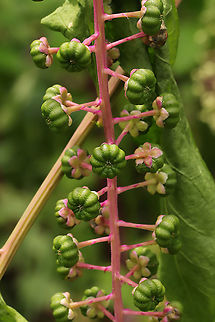
Naming
"Phytolacca americana" or pokeweed is also known as "pokeberry", "poke root", "Virginia poke", "pigeonberry," "inkberry", "redweed" or "red ink plant". When used in Chinese medicine, it is called "chuíxù shānglù" 垂序商陸(全國中草藥彙編),洋商陸(中國植物圖鑑),美國商陸(華北經濟植物誌要),美洲商陸(經濟植物手冊),美商陸(杭州藥用植物誌),洋商陸、花商陸、野胭脂、白雞腿, Foreign Shang Lu, American Shang Lu, American Shang Lu, American Shang Lu, Foreign Shang Lu, Florist Lu, Wild Rouge, White Chicken Leg (Jiangxi. As food, it is called "poke sallet", or more commonly "poke salad", sometimes spelled "polk salad". For example, used in Tony Joe White's 1968 song "Polk Salad Annie":Down there we have a plant that grows out in the woods, and the fields
And it looks somethin' like a turnip green
Everybody calls it polk salad
Now that's polk salad— Tony Joe White, Polk Salad Annie
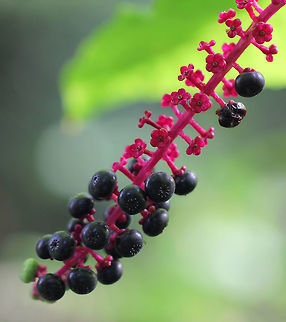
Distribution
Pokeweed is native to eastern North America, the Midwest, the Gulf Coast, and the West Coast of the US. It is an introduced weed in Japan.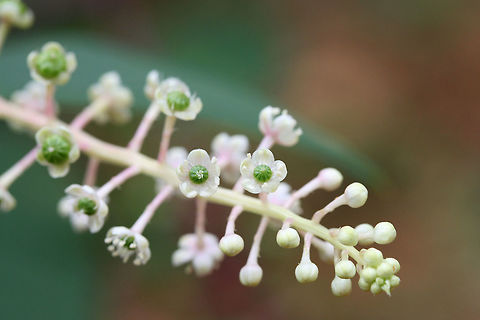
Habitat
Pokeweed is native to eastern North America, the Midwest, the Gulf Coast, and the West Coast of the US. It is an introduced weed in Japan.Birds are unaffected by the poisons in the berries, and eat them, dispersing the seeds. The berries are reported to be a good food source for songbirds and other bird species and small animals that are unaffected by its toxins. Distribution via birds is thought to account for the appearance of isolated plants in areas otherwise free from pokeweed.Pokeweed berries are reported to be a good food source for songbirds such as gray catbird, northern mockingbird, northern cardinal, brown thrasher, mourning dove, and cedar waxwing. Small mammals apparently tolerant of its toxins include raccoon, opossum, red and gray fox, and the white-footed mouse.
Pokeweed is sometimes used as a food source by black bears.
Pokeweed is used as a sometime food source by the larvae of some "Lepidoptera" species, including the giant leopard moth.
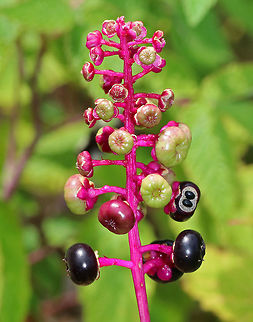
Food
Poke is a traditional southern Appalachian food. The leaves and stems of young plants can be eaten, but must be cooked by boiling two or more times with the water drained and replaced each time. The leaves taste similar to spinach; the stems, similar to asparagus. A 1917 article on edible weeds stated that pokeweed shoots were popular in Pennsylvania, "tied in small bundles, boiled the same way as asparagus, and served with cream sauce or melted butter."The roots are poisonous, as are mature leaves and stems. Some festivals still celebrate the plant's use in its historical food preparations.
As late as the 1990s two companies commercially canned and sold pokeweed, but in 2000 the last one, the Allen Canning Company of Siloam Springs, Arkansas, closed down its operation.
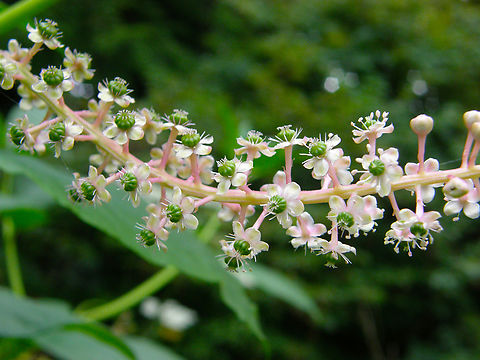
Defense
All parts of the plant can be toxic and pose risks to human and mammalian health. Toxins are found in highest concentration in the rootstock, then leaves and stems, then the ripe fruit. The plant generally gets more toxic with maturity, with the exception of the berries, which are dangerous even while green.Children may be attracted by clusters of berries. Ohio Agricultural Research and Development Center notes:
Children are most frequently poisoned by eating raw berries. Infants are especially sensitive and have died from eating only a few raw berries. Adults have been poisoned, sometimes fatally, by eating improperly prepared leaves and shoots, especially if part of the root is harvested with the shoot, and by mistaking the root for an edible tuber. Research with humans has also shown that common pokeweed can cause mutations and birth defects. Since the juice of pokeweed can be absorbed through the skin, contact of plant parts with bare skin should be avoided.
Pokeweed is to be avoided during pregnancy and children consuming even one berry may require emergency treatment. The plant sap can cause dermatitis in sensitive people.
The plant is not palatable to most animals and is avoided unless little else is available or it is present in contaminated hay, but horses, sheep and cattle have been poisoned by eating fresh leaves or green fodder and pigs have been poisoned by eating the roots.
If death occurs, it is usually due to respiratory paralysis.
Pokeweed poisoning was common in eastern North America during the 19th century, especially from the use of tinctures as antirheumatic preparations and from ingestion of berries and roots that were mistaken for parsnip, Jerusalem artichoke, or horseradish.
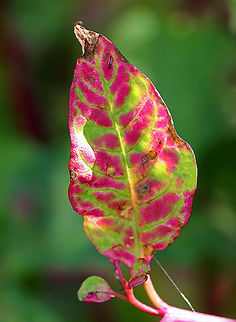
Uses
Poke is a traditional southern Appalachian food. The leaves and stems of young plants can be eaten, but must be cooked by boiling two or more times with the water drained and replaced each time. The leaves taste similar to spinach; the stems, similar to asparagus. A 1917 article on edible weeds stated that pokeweed shoots were popular in Pennsylvania, "tied in small bundles, boiled the same way as asparagus, and served with cream sauce or melted butter."The roots are poisonous, as are mature leaves and stems. Some festivals still celebrate the plant's use in its historical food preparations.
As late as the 1990s two companies commercially canned and sold pokeweed, but in 2000 the last one, the Allen Canning Company of Siloam Springs, Arkansas, closed down its operation.Plant toxins from "Phytolacca" are being explored as a means to control zebra mussels.
The toxic extract of ripe pokeweed berries can be processed to yield a pink dye. Early European settlers to North America would procure a fine red dye from the plant's roots.
During the middle of the 19th century wine often was coloured with juice from pokeberries.
"Phytolacca" contains lectins known as Pokeweed mitogen which are used to stimulate B-cell proliferation which is useful for B-cell assays, immunodeficiency diagnostic test, and immunotherapy.
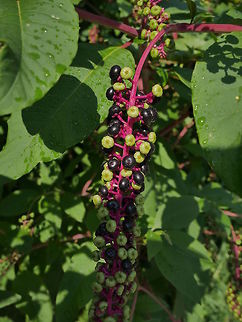
Cultural
Some pokeweeds are grown as ornamental plants, mainly for their attractive berries. A number of cultivars have been selected for larger fruit panicles.References:
Some text fragments are auto parsed from Wikipedia.